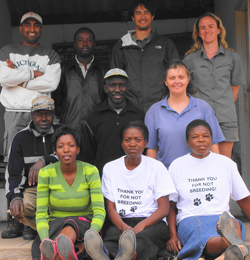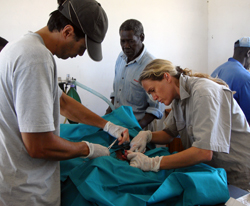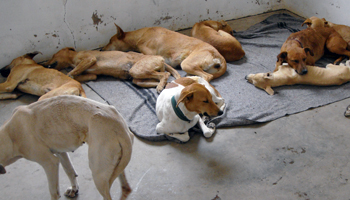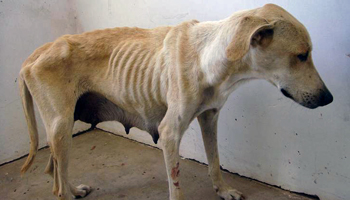GROUNDBREAKING STERILISATION PROGRAMME
The AWARE Trust team recently set out for Maramani Communal Land to perform its pilot dog sterilisation and vaccination programme. Maramani, which is 110km west of Beitbridge, was chosen because of its location within the Limpopo-Shashe Trans-Frontier Conservation Area (LSTFCA). AWARE believes that improving the health of domestic animals adjoining wildlife areas will benefit not only these animals and therefore the livelihoods of their owners, but will have a positive knock on effect for wildlife by limiting the spread of disease into wildlife populations and reducing poaching in wildlife areas.
The AWARE team

- AWARE veterinarians Dr Keith Dutlow and Dr Lisa Marabini
- Small animal private practitioner Dr Vinay Ramlaul (volunteer)
- Vin's surgical assistant Elliot Katanda
- Surgical assistant, pet checker and general dog lover Ashleigh Erlank (AWARE member and volunteer)
- Camp and surgery attendant Kenny Chitukudza
We worked in partnership with the following Department of Veterinary Services staff:
- Beitbridge District Veterinary Officer, Dr Columbus Chaitesvi
- Extension assistant Tarisayi Chuchu (stationed at Shashe Animal Health Centre (AHC, Maramani)
- Diptank attendant Denmore Ncube (stationed in Maramani)
- Animal science student Letty (watching practice with Dr Chaitesvi)
- 2 recently recruited vet department lady workers
We arrived at the Shashe AHC in Maramani at about 5pm on Sunday the 4th May, after a nine hour haul in 3 vehicles from Harare. The AHC consists of a 4 roomed building, which was run down, largely empty and devoid of electricity or water. We decided to use the 3 useable rooms as the ‘surgery’ as it would provide the most dust protection. We set up camp in the fading daylight in the grounds of the AHC, which at least gave us access to a ‘long drop’ toilet. Despite the fact that this programme had been advertised by posters, we were not sure what the response would be, and were discouraged when Chuchu thought that only 30 people would participate.
In action
The following morning we were discussing our options (should nobody turn up) over breakfast when the first patients were dragged reluctantly into the centre by two young boys. Patient 001 aka ‘Buster’ was a scrawny lactating bitch with two voracious eight week old pups at her teats, and 002 ‘Boss’ was her seven month old son. We had our first insight into these creatures’ lives when we asked if the dogs had eaten that morning (fearing possible vomiting during the anaesthetic), and were told that yes, they had had a few crumbs. Chuchu explained that most of the dogs don’t get fed as such, but have to scavenge left-overs which are likely to be very infrequent in this area.
Everybody jumped into action. Elliot and Kenny set about cleaning up the dusty building. Preparations included mixing up the pre-medication (ACP/atropine); mixing up the injectable anaesthetic (good old fashioned thiopentone); setting up the anaesthetic machine; attaching nylon used for suturing to needles; ensuring that all the kits, drapes and swabs for the day had been sterilised in our autoclave; ensuring that the vaccines were packed in a cooler box with solid ice packs from the freezer; and checking the laryngoscope, pulse oximeter and ET tubes were accessible and functioning correctly. Letty, meanwhile, being able to speak the local language Venda, took charge of recording all the owners’ details and treatments given to the dogs.
The first two patients were subservient (belying the mayhem that would ensue later) and pre-medicating them was not a problem. Once the drugs had taken effect, each dog was brought into the ‘knock-down’ room where it was checked out, its foreleg was clipped and it was given intravenous thiopentone. This was followed by intubation, and shaving and ‘prepping’ (scrubbing with disinfectant) of the surgical site. At this point each dog was given a long acting shot of penicillin, and vaccinated for rabies and DA2PPL (5n1). The dog was then carried through to the table (that we had brought with us) in the main ‘theatre’, where it was attached to the anaesthetic machine and pulse oximeter. We had borrowed a 200l water drum full of water from Sentinel Ranch. Water for surgery use was decanted into stainless steel buckets and the surgeon and his assistant would scrub-up with someone else pouring water from a jug. Sterile surgical gloves were used for all spays, but not castrations.
 Vin was only available for a week, so he offered his surgical prowess up for exploitation, which Keith and Lisa took advantage of – relentlessly! By the time he was through with the first spay, several more patients had turned up and been pre-medicated. After Keith did a couple of spays that morning to ‘get his hand in’, a system developed, where one vet would knock out a spay, and after prepping, this animal would be carried through to theatre where Vin and Elliott would be scrubbed up and waiting for it. On a rotational basis, one vet would be required to monitor the anaesthetic whilst Vin operated. As he was closing the abdominal muscle layers he would call for the next spay to be anaesthetised and prepped up. The third vet would do this.
After the dogs were operated on, they were laid on a blanket in a third ‘recovery’ room where Denmore was taught how to do post-operative monitoring, and how to extubate the dog when it was ready. All dogs received a much needed application of Frontline Topspot for ticks and fleas in the recovery room. In addition a blood sample was taken from each dog at this time in order to study what pathogens the dogs have been exposed to.
Once the system was operating smoothly, we managed to time it so that a castration could be done in the knockdown room on intravenous anaesthetic alone whilst Vin was spaying in the theatre. This would involve the third vet operating and the fourth vet monitoring the second anaesthetic. By the end of the first day, six spays and four castrations had been performed.

The dogs in the recovery room tolerated each other remarkably well (at times there were 15 dogs in various stages of recovery in the same room). They were discharged in the late afternoon, when some of them would have to walk 6-10km to get home. The lucky ones were light enough to be carried by the owner, or would go home in a donkey-drawn scotch cart. The owner of each dog was given a roughly 1kg bag (per dog) of Fetch dog kibbles as it was felt that this would give them a head-start with the healing process. The children also received a storybook about a dog which aims to educate children and promote compassion for animals. The owners received an AWARE T-shirt and were instructed to bring their dogs back in 72 hours for a check-up, at which point they would be de-wormed. Unfortunately, return rates were quite low, attributed to the long distances some of these people had walked from, although Chuchu assured us that if there was a problem the owners would bring their dogs.
There was never a quiet moment in the mornings that followed. In between times the fourth vet, assisted by Ashleigh and Chuchu, would be required to vaccinate dogs that were not being operated on. Puppies less than 12 weeks old were vaccinated with canine parvo vaccine, de-wormed with fenbendazole and sprayed with Frontline spray. Dogs over 3 months were vaccinated for rabies and DA2PPL, and received an application of Frontline Topspot and fenbendazole de-wormer.
Restraining some of these dogs proved to be a real challenge. Not surprising with names like ‘Saddam’ and ‘Bin Laden’. Many of them are not used to being handled, and two of the castrations had to be pole-syringed with Zoletil in order to anaesthetise them. The villagers have a habit of gripping the dogs round their throats and lifting them off the ground which only serves to incense the terrified mutt. They are also sometimes tied to poles with non-release rope so a few of them ended up nearly strangling themselves in an effort to get away. We were actually pleased when our quality lead and choke-chain was stolen (sorry, Matsumi!) – at least one dog will not have to endure this treatment. As Ashleigh found out this was often quite traumatic to watch, and resulted in much screaming and pandemonium outside (dogs and people!) whilst inside Vin continued to churn out spay after spay with unflappable calm.
It was also necessary to conduct a medical clinic outside, as several sick dogs were presented for treatment. We saw two cases where dogs had been poisoned by eating bait that was set for hyaenas. The latter, which we heard calling every night, appear to be a source of conflict for these villagers. We saw first hand evidence of two donkeys that had survived a hyaena attack – one had had her teats ripped off and could therefore not feed her offspring, and the other had a deep chunk of flesh missing from his perineum. There were also a number of reports of hyaenas taking goats, and as it turns out this is one of the main reasons villagers keep dogs – to warn them of hyaenas during the night. The poison used is a pesticide allegedly stolen from nearby citrus estates, and causes a slow deterioration and death within a week, possibly through liver failure. One of these dogs died despite our supportive treatment and intravenous fluids. Interestingly, despite the large numbers of ticks on the dogs, no biliary (Babesia) parasites were seen under the microscope on any of the blood-smears taken. It was felt that there was possibly a low grade tick fever in some of these dogs as their white blood cell counts appeared to be quite low.
Donkeys were not turned away either. A couple with maggot-infested wounds were treated, and one with a severely overgrown ‘slipper’ hoof received a pedicure. Generally these donkeys were in much better condition than the donkeys in lower Gweru, and we saw no overt signs of donkey cruelty as in Gweru.
Operations would generally finish by lunchtime. After a bite to eat, Ash and Lisa would then process the blood samples (centrifuge whole blood and remove the serum by pipetting to separate Nunc tubes). The boys would take the 200l drum and go and fetch water from a nearby manual borehole. We had erected a shower tent, and bathed from a solar shower bag that Ash had thought to bring. Occasionally we would all go and wash our hair at the borehole, much to the disgust of the donkeys and goats that take the opportunity to drink any spilled fresh water when someone pumps the borehole. Our drinking water was purified with tablets.
We did experience some peri- and post-operative complications. Since most of these dogs were extremely nutritionally stressed, keeping a close eye on the anaesthetic was critical. In several instances dogs became apneic or cyanotic during the surgery and needed straight oxygen for recovery. For this reason, no bitch spays were done under simple intravenous anaesthetic, nor will they be attempted on dogs in this state of health in the future.
Our very final castration, which received the same dose of anaesthetic as all the others, seemed to be taking ages to wake up. Some time later when this dog had still not raised its head, we took its temperature and found it to be 32’C! We immediately got it into the boiling hot sun with blankets and a hot water bottle. Keith struggled, but eventually found a saphenous vein into which we ran a litre of warm saline and a little adrenaline and dexone. It took 2 extremely stressful hours for this dog’s temperature to come back up to 35’ at which point it started waking up. Another indicator of these dogs’ borderline health status was that on days one and two, we were routinely giving a normal dose of ketoprofen to the dogs for pain relief. There seemed to be a lot of subcutaneous bleeding, so that the floor of the recovery room had drops of blood all over it. We decided to stop the Ketofen in case it was having an anti-coagulant effect, and from that day the bleeding stopped.

Of the dogs that came back for their post-operative checks, 6 had elevated temperatures. 3 of these were eating and behaving normally so it was felt their temperatures may have resulted from walking some distance to the clinic or stress. They were given a further shot of long acting penicillin. One of the other 3 was extremely thin, and had an enormous white cell count on her blood smear. Even after 4 days of treatment with enrofloxacin and cephalexin her temperature was still fluctuating (only Ketofen brought it down). It is possible she had another concurrent illness. She continued to eat, however, and was left with medication to continue after we left the area. Another dog that was in season and was also recovering from a baboon bite when she was spayed went home and was mated that night. She appeared to be in pain and lethargic on review, and had a high temperature. This dog was treated with an intravenous drip, ketofen, enrofloxacin and cephalexin, which she went home on. The third complication was a lactating bitch whose pups were about a week old. She was agitated, panting and had a high temperature. We felt she might be a candidate for eclampsia, but unfortunately had no calcium to treat her with. She was also treated with an intra-venous drip, anti-biotics and several highly nutritious plates of food – our sardines, eggs, and concentrated powdered milk, which she wolfed down gratefully. By the end of the day she was calm, and when we took her off her drip she trotted off home by herself to feed her puppies.
One other bitch spay that came back with swelling at her incision site was knocked out for a second time to check whether the swelling was an incisional hernia. Fortunately it was just a blood clot, which was removed and the skin stitches replaced. No further problems have been reported to date.
Vin left early Sunday morning. The team decided that it was prudent to stop spaying the animals 72 hours before we left the area to be able to deal with any complications that might need surgical intervention. We were running out of gas for the steriliser, and fatigue had set in. The rest of the team decided to depart on Wednesday 13th. Our last spays were done on Sunday 10th. On Monday 11th we had a zero turnout because FAO-sponsored government vaccinators were vaccinating cattle for anthrax and dogs for rabies in the area. We were pleased to learn that at the nearby Limpopo Diptank there were only 2 dogs presented for rabies vaccine that had not been seen by us. At Maramani diptank, which is about 15km away, 28 dogs were vaccinated
that had not been seen by us. At Machuchuta Diptank, more than 30km away, over 300 dogs were vaccinated by the government – evidently this was too far away for people to come to us. This would be a good area to target for our next campaign.
In total between the 5th and 12th of May, AWARE spayed 44 bitches and castrated 46 male dogs making a total of 90 sterilisations. 165 dogs were vaccinated, Frontlined and de-wormed and several more were treated for illness.
The table below shows the number of dogs that were operated on:
| Day |
Mon |
Tues |
Wed |
Thurs |
Fri |
Sat |
Sun |
Mon |
Tues |
Total |
| Spayed |
6 |
7 |
7 |
7 |
6 |
8 |
3 |
0 |
0 |
44 |
| Neutered |
4 |
7 |
7 |
7 |
5 |
7 |
8 |
0 |
1 |
46 |
| Total |
10 |
14 |
14 |
14 |
11 |
15 |
11 |
0 |
1 |
90 |
Thanks
We are sincerely indebted to the following people who made this campaign possible:
- NSPCA Blue Cross, and in particular Christine Shields. Blue Cross funds paid for the anaesthetic drugs, long acting antibiotics, surgical gloves, catgut, Scrub-up and methylated spirits.
- Dr Vinay Ramlaul, who worked like a Trojan, brought his own vehicle down, and loaned us his anaesthetic machine, 2 surgical kits and several other surgical bits and pieces. He also refused to accept petrol coupons for the trip as he found the work so emotionally gratifying. We are pleased to announce he has joined the AWARE veterinary team. (This still being a voluntary team as none of the vets are salaried by AWARE yet!)
- Ashleigh Erlank and Elliot Katanda for their dedicated hard work and commitment to performing the best possible work under difficult circumstances.
- All the Veterinary Department personnel who were enthusiastic and a pleasure to work with, and without whom we would not have had such good co-operation from the villagers.
- Medi-Vet P/L (Zimbabwe) who sponsored the de-wormer, 80 kg of Fetch dog kibbles and the T-shirts, and who imported the drugs on AWARE’s behalf.
- Nadia Marabini for a cash donation of US$1000.
- Merial South Africa for their generous donation of Frontline Topspot and Spray.
- The Wildlife Veterinary Unit for the loan of a vehicle, microscope, camping and blood processing equipment.
- Cactus Advertising, Design and Print, in particular Sue Burr who organised the reproduction of the advertising posters and the educational storybooks. These are originally by Animal Voice in South Africa, who gave permission for their reproduction.
- Chisipite Veterinary Surgery for the loan of a surgical pack.
- Alpesh Patel for his donation of mutton cloth.
- Vetpharm, in particular Russell Hendrix for his donation of cotton wool.
- Fivet who gave us a 10% discount on the DA2PPL and parvo vaccines.
- Meryl Harrison for her donation of consumables.
Having seen that spay campaigns are definitely feasible for AWARE to run in marginal areas, we have decided to try to raise the funds to run 3 or 4 of these per year. Below is a wishlist of items needed that will help the next campaign to be even more effective. You can buy our T-shirts at the 24 Hour Veterinary Surgery.
- Anaesthetic machine.
- Sponsorship for drugs and consumables.
- Three more spay kits including drapes.
- Fuel.
- Vehicle servicing and maintenance.
- Mobile operating unit (vehicle with theatre) to service people who live too far to walk to centres.
- Microscope.
- Centrifuge.
- Choke chains and metal leads to give to dog owners.
- Crayons to give children (for colouring in the storybooks).
- Dog kibbles.
- Palatable de-wormer in tablet form, as liquids are very difficult to get down some of these dogs.
- Vaccine (DA2PPL and rabies).
- Sponsorship for T-shirts.
- Sponsorship for salaries for AWARE staff.
|